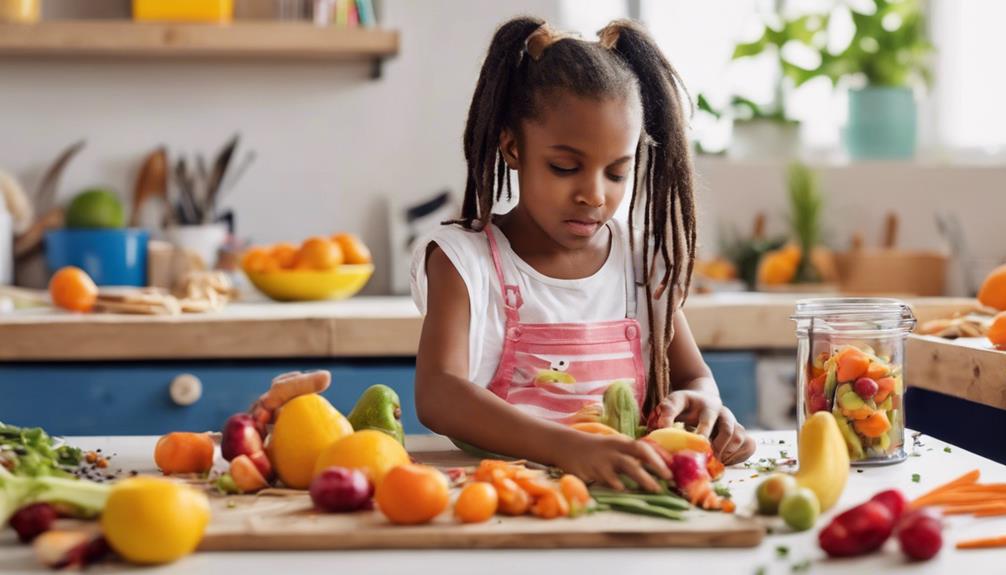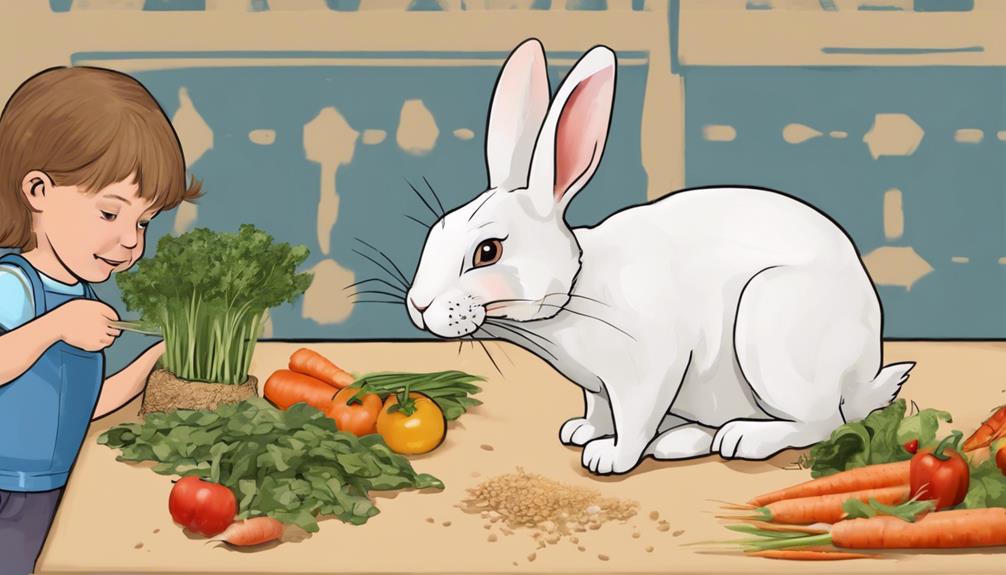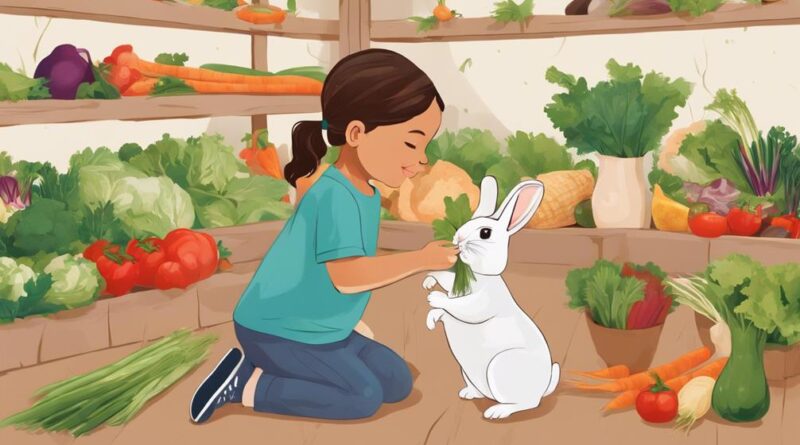10 Best Ways to Teach Kids About Rabbit Diets
To teach kids about rabbit diets, start with interactive feeding demos, DIY pellet mixing, and fresh veggie chopping. Engage them with fun diet charts, games, and storytelling sessions about bunny nutrition. Guide children in practical activities like foraging in the garden and meal planning. Make it hands-on by involving them in preparing rabbit-friendly treats and supervising veggie chopping. Interactive methods, like planning a weekly menu and role-playing, enhance their learning experience. Consider field trips to rabbit sanctuaries for a firsthand look at proper care. These activities will help kids grasp the importance of balanced diets for their furry pals.
Importance of Rabbit Diet Education
Understanding the importance of educating children about rabbit diets is crucial for their well-being and development as responsible pet owners. Nutritional knowledge is key in ensuring that rabbits receive a balanced diet that meets their specific dietary needs. By involving parents in this educational process, children can learn the importance of providing proper nutrition to their furry friends.
Introducing age-appropriate educational materials and activities can make learning about rabbit diets engaging and fun for kids. Hands-on learning experiences, such as preparing and serving rabbit-safe vegetables or fruits, can help children understand the significance of feeding their rabbits a healthy diet. Parents can play a vital role in reinforcing these lessons by supervising and guiding their children during feeding times.
Interactive Feeding Demonstrations
Engage children in hands-on experiences by conducting interactive feeding demonstrations to teach them about proper rabbit diets. By creating feeding simulations and interactive learning opportunities, you can make the educational experience both fun and informative for kids.
Here's how you can conduct rabbit diet experiments and kitchen adventures to help kids understand the importance of a balanced rabbit diet:
- DIY Pellet Mixing: Allow children to mix different types of rabbit pellets to understand the importance of variety in a rabbit's diet.
- Fresh Vegetable Chopping: Teach kids how to chop and prepare fresh vegetables that rabbits enjoy, emphasizing the role of fiber and nutrients in their diet.
- Hay Sorting Activity: Engage children in a hay sorting activity where they separate different types of hay used for rabbit feeding, highlighting the significance of hay in a rabbit's daily nutrition.
- Portion Control Game: Create a portion control game where kids learn to measure and allocate the right amount of food for a rabbit's meal, teaching them about moderation.
- Observation and Feedback: Encourage children to observe the rabbits' reactions to different foods during feeding demonstrations, allowing them to understand a rabbit's preferences and nutritional needs firsthand.
Through these interactive feeding demonstrations, kids can gain practical knowledge about rabbit diets while having a hands-on and engaging learning experience.
Fun Rabbit Diet Charts
To make learning about rabbit diets more enjoyable, consider incorporating fun rabbit diet charts that visually represent the nutritional needs of these furry pets. Interactive games can be a great way to engage kids in understanding what foods are essential for their rabbit's health. You can create a game where children match different types of vegetables or fruits to the corresponding nutrient categories on the chart. This hands-on approach helps them learn about the importance of a balanced diet for their fluffy friends.
Colorful infographics are another fantastic tool to teach kids about rabbit nutrition. By using vibrant images and simple explanations, children can easily grasp which foods are suitable for rabbits and which ones are not. You could hang the infographic in a prominent place where kids can frequently see it, reinforcing their learning in a fun and visual way.
Encourage children to participate actively in feeding time by referring to the diet chart. Let them choose the vegetables or fruits to give to the rabbit based on what they've learned. This involvement not only educates them about proper rabbit nutrition but also fosters a sense of responsibility towards caring for their pet. By incorporating interactive elements and colorful visuals, teaching kids about rabbit diets can be both enjoyable and educational.
Storytime With Rabbit Nutrition
Delve into the world of rabbit nutrition through engaging storytelling sessions that bring to life the importance of a healthy diet for these adorable pets. Storytime can be a fantastic way to educate kids about the significance of nutritious snacks and proper meal planning for their rabbit companions.
Here's how you can make these sessions informative and fun:
- Interactive Tales: Use storytelling as a tool to introduce the concept of nutritious snacks for rabbits. Describe scenarios where a rabbit's health improves by eating fresh vegetables and high-quality hay.
- Character Development: Create characters in your stories that exemplify the benefits of meal planning for rabbits. Show how a well-balanced diet makes the rabbit energetic and happy.
- Visual Aids: Incorporate pictures or drawings of various rabbit-friendly foods during the storytelling. This visual representation can help children understand what foods are good for their furry friends.
- Engaging Narratives: Craft narratives that involve the process of selecting and preparing meals for a rabbit. This can instill a sense of responsibility in children towards their pet's diet.
- Happy Endings: Conclude each story with the rabbit being healthy and vibrant due to the nutritious snacks and careful meal planning. This reinforces the positive impact of a good diet on the rabbit's well-being.
Hands-On Veggie Chopping
As you move from storytelling sessions to a more hands-on approach, involve children in the practical skill of chopping veggies for their rabbit's diet. This activity not only teaches kids about the importance of fresh vegetables in a rabbit's nutrition but also enhances their understanding of responsibility and care for their furry friends.
Start by incorporating garden foraging into the activity. Encourage children to explore the garden and pick out fresh veggies that are safe and healthy for rabbits. This hands-on experience will help them connect with nature and understand where their pets' food comes from.
Next, involve the kids in meal planning for the rabbits. Discuss the importance of a balanced diet and guide them in selecting a variety of vegetables to chop. Teach them about portion sizes and how different vegetables provide various nutrients essential for their rabbit's health.
When it comes to chopping the veggies, show the children the proper techniques using child-safe knives or kitchen tools. Supervise them closely to ensure safety while they learn this valuable skill. This hands-on activity not only educates kids about rabbit diets but also fosters their motor skills and independence in caring for their pets.
Rabbit Feeding Schedule Activities
Exploring engaging rabbit feeding schedule activities can help children develop a structured routine for caring for their furry companions. When it comes to rabbit nutrition and feeding habits, it's essential to establish a consistent schedule to ensure your pet stays healthy and happy.
Here are some fun activities to incorporate into your daily rabbit feeding routine:
- Mealtime Chart: Create a colorful chart that outlines the different feeding times for your rabbit. Let your child be in charge of marking off each meal as it's given to the rabbit, teaching them responsibility and time management.
- Food Sorting Game: Prepare different types of rabbit-friendly foods and have your child sort them into categories such as vegetables, hay, and pellets. This activity helps children understand the importance of a balanced diet for their rabbit.
- Feeding Scavenger Hunt: Hide small portions of your rabbit's food around their living area and encourage your child to find and feed them. This activity makes feeding time interactive and engaging for both the child and the rabbit.
- Feeding Chore Rotation: Assign different feeding tasks to each family member on a rotating schedule. This not only ensures that the rabbit is fed consistently but also teaches children the importance of teamwork in caring for pets.
- Meal Planning: Sit down with your child and plan out a weekly menu for your rabbit, including different foods and portion sizes. This activity helps children learn about meal preparation and the significance of variety in their pet's diet.
DIY Rabbit Treat Making

To expand your children's understanding of rabbit care and nutrition, consider engaging them in the creative and educational activity of DIY Rabbit Treat Making. Making tasty treats for your furry friends can be both fun and rewarding. It allows children to learn about the importance of providing healthy snacks for their rabbits while also promoting creativity through crafting unique treats.
One simple and popular DIY rabbit treat is the carrot and banana bites. To make these, mash a ripe banana and mix it with finely grated carrots. Then, shape the mixture into small bite-sized balls and place them on a tray to freeze. Once frozen, these treats can be given to your rabbits as a delicious snack.
Another creative idea is to make hay and herb bundles. Take a mixture of your rabbit's favorite fresh herbs and wrap them in a bundle with some hay. Secure the bundle with a piece of twine and hang it in your rabbit's enclosure. Not only will this provide a tasty treat, but it will also encourage natural foraging behavior.
Engaging in DIY rabbit treat making not only teaches children about healthy rabbit diets but also fosters a sense of responsibility and care for their pets. So, gather your ingredients and embark on a journey of crafting tasty treats and creative crafts for your beloved bunnies.
Rabbit Diet Quiz Games
Ready to test your knowledge on rabbit diets in a fun and engaging way? Educational rabbit games and quiz competitions are a fantastic way to make learning about rabbit diets interactive and enjoyable. Here are some ideas to incorporate quiz games into your educational activities:
- Diet Bingo: Create bingo cards with different rabbit-friendly foods or diet-related terms. As you call out the items, players mark them off on their cards. The first to get a line or full house wins a prize!
- Quiz Competition: Organize a quiz competition where participants answer questions about rabbit diets. Include multiple-choice questions, true or false statements, and fill-in-the-blank prompts to keep the game exciting and informative.
- Interactive Learning: Use multimedia tools like interactive quizzes online or through apps to engage children in learning about rabbit diets. These tools can provide immediate feedback and explanations, enhancing the learning experience.
- Prizes and Rewards: Offer small rewards or prizes for correct answers to keep participants motivated and enthusiastic about learning. This can range from stickers and certificates to small treats or toys.
- Team Challenges: Encourage group participation by organizing team challenges where kids work together to answer questions. This fosters collaboration and teamwork while learning about rabbit diets.
Integrating quiz games into your educational activities can make learning about rabbit diets both educational and entertaining for kids.
Role-Playing Rabbit Feeding

As you engage in teaching kids about rabbit diets through fun and interactive methods like quiz games, another creative approach is to involve them in role-playing scenarios of rabbit feeding. Role-playing scenarios can be a hands-on and engaging way for children to understand the importance of proper nutrition for rabbits. By participating in feeding simulations, kids can learn about the types of foods rabbits eat, portion sizes, and feeding schedules.
To set up a role-playing scenario, create a pretend rabbit feeding area with different types of rabbit-safe foods such as hay, vegetables, and pellets. Assign roles to the children, such as the rabbit caregiver and the rabbit, and guide them through a feeding routine. Encourage the caregiver to choose the appropriate foods, measure out the correct portions, and interact with the 'rabbit' in a gentle and caring manner.
Through these role-playing activities, children can learn about the nutritional needs of rabbits, the importance of a balanced diet, and the significance of regular feeding times. They can also develop empathy and responsibility by taking on the role of the caregiver and understanding the impact of their choices on the 'rabbit's' health and well-being.
Field Trip to a Rabbit Sanctuary
Consider planning a visit to a local rabbit sanctuary to provide kids with a firsthand experience of caring for rabbits and understanding their needs. A field trip to a rabbit sanctuary can be an enriching and educational experience for children, allowing them to observe these adorable creatures up close and learn about the importance of proper care and nutrition for rabbits.
- Animal Interactions: Children can interact with the rabbits under the supervision of sanctuary staff, petting and feeding them while learning about their behavior and social needs.
- Educational Games: Engage kids in fun and educational games that teach them about rabbit diets, grooming, and other aspects of rabbit care.
- Wildlife Observation: Encourage children to observe the rabbits in their sanctuary environment, noting their natural behaviors and interactions with each other.
- Feeding Routines: Learn about the feeding routines of the rabbits at the sanctuary, understanding the importance of a balanced diet for their health and well-being.
- Guided Tour: Take a guided tour of the sanctuary to see how the rabbits are cared for, their living spaces, and the efforts taken to ensure their comfort.
Frequently Asked Questions
Can Rabbits Eat Flowers and Herbs as Part of Their Diet?
Yes, rabbits can eat certain flowers and herbs as part of their diet. Edible flowers like pansies and herbs such as parsley provide nutritional benefits like vitamins and minerals. However, some plants can be harmful, so it's crucial to research before feeding.
Always introduce new foods slowly and monitor for any adverse reactions. Consulting a veterinarian for a list of safe options is recommended to ensure your rabbit's diet is balanced and healthy.
How Can I Prevent My Rabbit From Becoming Overweight?
To prevent your rabbit from becoming overweight, focus on exercise routines and portion control. Encourage daily playtime and provide opportunities for hopping and running.
Control their food portions to ensure they aren't overeating. Offer a balanced diet with hay, fresh vegetables, and limited pellets to promote healthy weight.
Are There Any Special Dietary Considerations for Baby Rabbits?
When it comes to baby rabbit growth, remember that the weaning process is crucial. Ensure their diet consists of high-quality hay, fresh veggies, and limited pellets.
Gradually introduce new foods to avoid digestive issues. Baby rabbits need a balanced diet rich in fiber and nutrients to support their growth.
Monitor their weight regularly and adjust their diet as needed. Providing proper nutrition during this stage sets the foundation for a healthy adult rabbit.
What Types of Treats Are Safe for Rabbits to Eat Occasionally?
When giving your rabbit healthy snacks, it's essential to maintain dietary balance. Some safe treats for rabbits to eat occasionally include fresh fruits like apples and berries, leafy greens such as kale and parsley, and even small amounts of carrots or herbs like cilantro.
These treats can provide variety in their diet and be a great way to bond with your furry friend while ensuring they stay healthy and happy.
How Can I Transition My Rabbit to a New Diet Without Upsetting Their Stomach?
To transition your rabbit to a new diet without upsetting their stomach, start by slowly introducing small amounts of the new food while still providing their current diet. Monitor their progress closely, noting any changes in appetite or digestion.
Gradually increase the new food while decreasing the old one over a week or two. This gradual transition helps prevent digestive issues and allows your rabbit to adjust to the new diet more comfortably.
Conclusion
In conclusion, teaching kids about rabbit diets can be a fun and interactive experience that helps them understand the importance of proper nutrition for their furry friends.
By incorporating hands-on activities, games, and educational resources, children can learn how to provide a well-balanced diet for their rabbits.
These lessons can't only benefit the health and well-being of the rabbits, but also help instill a sense of responsibility and compassion in young animal lovers.
